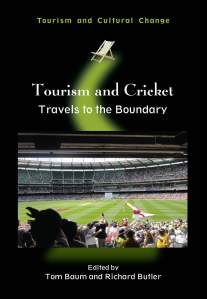Just published this week in time for England’s latest test match, Tourism and Cricket edited by Tom Baum and Richard Butler is the first book to focus on the relationship between tourism and cricket. Here, Richard Butler explains a bit about the unique nature of cricket tourism.
Football and rugby notwithstanding, it is summer which is really the sporting season, and nothing epitomises summer in England more than cricket. As in the United States with baseball, summer afternoons and evenings seem highly suited to the crack of a bat on a ball. There are marked similarities between baseball and cricket, both involve bat and ball, both are team sports, and yet both essentially come down to one man with a ball throwing it at one man with a bat. The other players are secondary to the personal competition between two individuals. Both sports have contributed to the language of their respective host countries, cricket via more than twenty phrases at the last count (including “a sticky wicket” and “stumped”, as well as the summation of the spirit of the game in “It’s not cricket”) and baseball has made it into the lexicon of English clichés with “stepping up to the plate” and “striking out” at least.
 Where these summer iconic activities differ most however, is in the duration and frequency of play and the travel patterns of their supporters. While most first class cricket teams play in the region of forty games a season, including county championship, limited over and Twenty20 formats, major league baseball teams play one hundred and sixty two games in a season and up to an additional twenty one in the misnamed “World Series” should they make the playoffs. It is unlikely any baseball fan watches live all the games his or her team plays in a season, as attendance would require massive travelling across North America with great frequency, even allowing for the fact that some days see two games played between the same teams.
Where these summer iconic activities differ most however, is in the duration and frequency of play and the travel patterns of their supporters. While most first class cricket teams play in the region of forty games a season, including county championship, limited over and Twenty20 formats, major league baseball teams play one hundred and sixty two games in a season and up to an additional twenty one in the misnamed “World Series” should they make the playoffs. It is unlikely any baseball fan watches live all the games his or her team plays in a season, as attendance would require massive travelling across North America with great frequency, even allowing for the fact that some days see two games played between the same teams.
In the case of cricket however, such devotion to a team is possible and the distance and frequency of travel would be much less. In the case of national teams however, patriotic cricket fans become true international tourists compared to their American counterparts, whose international experience would be mostly non-existent as baseball is only played in a very few countries with no real international competition. Thus cricket encourages tourism on a considerable scale, if not in vast numbers, certainly in terms of per capita distance covered and time involved. The travels of the “Barmy Army” as the English supporters’ association is known sees some of its members travelling half way round the world for several weeks to support their team in test matches in Australia and New Zealand in particular. As well, it is not just the players and spectators who travel, because, as Michael Atherton recently pointed out there are at least as many backroom staff as players.
The links between cricket and tourism are explored in our new book just published by Channel View, Tourism and Cricket: Travels to the Boundary. The book examines the origins of international cricket, issues relating to the grounds, the travails and travels of both participants and fans, and the influence of cricket on the attitudes and behaviours of the supporters.
 For more information about this book, please see our website. If you found this interesting, you might also like Sport Tourism Development by Tom Hinch and James Higham.
For more information about this book, please see our website. If you found this interesting, you might also like Sport Tourism Development by Tom Hinch and James Higham.